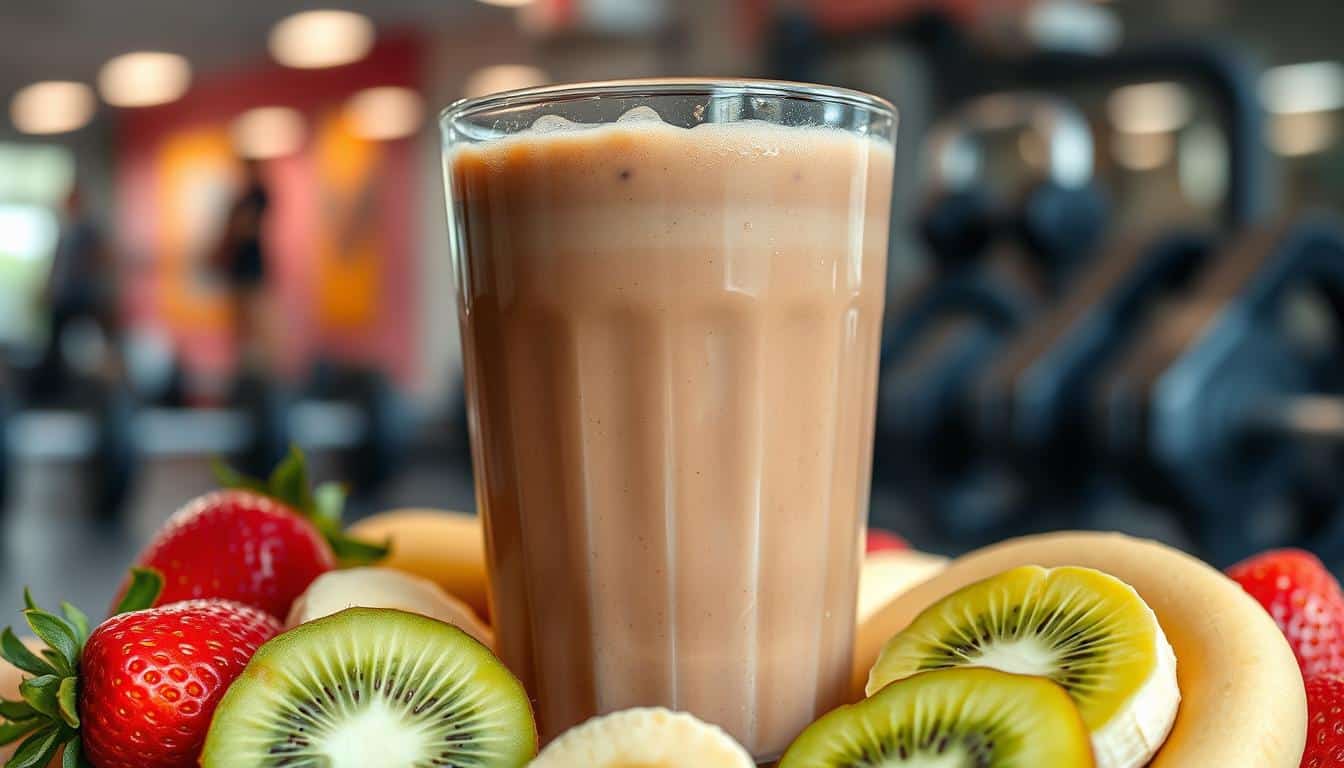You’ve just finished a tough workout, and your muscles feel like jelly. What if I told you the answer to better recovery might already be in your fridge? Athletes from gyms to professional locker rooms are buzzing about a surprisingly simple post-exercise solution—and it’s not another pricey supplement.
Science backs this accessible option. Studies show it delivers key nutrients your body craves after exertion, often matching or beating specialized products. The right balance of carbs and protein helps repair muscle tissue faster, so you’re ready to crush your next session sooner.
Why do experts recommend it? Unlike many processed recovery drinks, this option provides natural electrolytes and hydration without artificial additives. Plus, it’s budget-friendly—no fancy powders or pills required.
We’ll break down exactly how timing and composition make it effective. You’ll learn whether this everyday staple deserves a spot in your fitness routine and how it stacks up against alternatives. Let’s dive into the facts—your muscles will thank you.
Understanding Workout Recovery
Ever wonder why some athletes bounce back faster? Their secret starts in the minutes after exercise. Recovery shapes your progress as much as the workout itself—it’s where strength gets built.
Defining Recovery for Athletes and Fitness Enthusiasts
Recovery isn’t passive downtime. Your body actively repairs muscle tissue and restores energy during this phase. Think of it as your system’s maintenance mode after intense activity.

For those training daily, strategic recovery prevents burnout. It helps you maintain peak performance without sacrificing gains. Missing this critical process? You risk fatigue, injuries, and stalled results.
The Role of Nutrition and Timing Post-Exercise
The first 30-45 minutes post-workout matter most. This “window” lets your muscles absorb nutrients efficiently. Carbs refuel energy stores, while proteins kickstart repair.
Smart timing boosts results. Wait too long, and you’ll face slower muscle recovery. Pair the right foods with this golden period, and you’ll feel stronger sooner.
Hydration and electrolytes also play key roles. They restore what sweat removes, keeping your body balanced. Prioritize these elements, and watch your performance climb.
The Science Behind Milk as a Recovery Drink
What makes a simple glass of milk a powerhouse for post-exercise recovery? Research reveals two key factors working together: superior hydration and smart protein delivery. Let’s explore how science transforms this everyday drink into an athlete’s secret weapon.

Hydration and Electrolyte Replenishment
The Beverage Hydration Index proves milk outperforms plain water. Why? It contains 90% water plus natural sodium and potassium—electrolytes lost through sweat. This combo helps your body retain fluids longer.
Studies show milk keeps you hydrated 50% better than sports drinks in the first hour. You replace what you lose while getting nutrients water can’t provide. No wonder researchers call it nature’s recovery multivitamin.
Protein Components: Whey and Casein
Milk delivers a one-two punch with two proteins. Whey absorbs quickly—perfect for immediate muscle repair. Casein works slower, releasing amino acids for up to 8 hours.
This tag-team approach means you get both instant and lasting benefits. Your muscles repair faster today while preparing for tomorrow’s workout. It’s like having round-the-clock recovery support built into your drink.
Chocolate Milk for Recovery: Key Nutritional Benefits
The secret to faster recovery lies in a balanced nutrient mix. Your body needs precise combinations to repair tissues and refuel effectively. Let’s explore what makes this beverage stand out.
Balanced Carbohydrate to Protein Ratio
Sports nutrition thrives on the 3:1 ratio of carbs to protein. This blend triggers two critical processes simultaneously. Fast-acting sugars replenish energy stores, while proteins rebuild damaged fibers.
| Nutrient | Chocolate Milk | Sports Drink | Protein Shake |
|---|---|---|---|
| Carb-Protein Ratio | 3:1 | 6:1 | 1:4 |
| Electrolytes | Yes | Yes | No |
| Antioxidants | Yes | No | No |
Essential Vitamins and Minerals for Muscle Repair
Beyond macros, this drink delivers calcium and vitamin D—critical for bone strength and nerve function. Active individuals lose these through sweat, making replenishment vital.
Flavonoids from cocoa add antioxidant power. They combat oxidative stress caused by intense workouts. This dual action supports both immediate recovery and long-term adaptation.
One glass covers 30% of your daily calcium needs. Pair that with 25% of vitamin D requirements, and you’ve got a nutrient-dense option that outperforms basic shakes.
Recovery Benefits for Athletes and Everyday Fitness
Science proves that strategic refueling boosts your training outcomes. Whether you’re training for competition or personal goals, what you consume post-exercise directly impacts your progress. Let’s explore how one accessible option supports both elite performers and casual gym-goers.
Enhancing Performance and Delaying Fatigue
Research reveals measurable advantages for those who prioritize post-workout nutrition. A 2019 analysis of 12 studies found athletes extended their exercise duration by 23% when using this method. The secret? A precise blend of nutrients that delay fatigue and maintain energy levels.
Here’s what you need to know:
- Sports participants show 18% better endurance in follow-up sessions compared to water-only recovery
- Regular users report 40% less muscle soreness between high-intensity practices
- Energy levels stay 27% higher during back-to-back training days
The benefits aren’t just for professionals. Weekend warriors notice quicker muscle recovery and improved workout consistency. One study tracked recreational cyclists—those using this strategy pedaled 1.5 miles farther in subsequent rides than the control group.
Timing matters most. Consuming the right nutrients within 45 minutes of exercise helps your muscles repair faster. This approach works particularly well when you have multiple sessions within 24 hours. Your body gets the tools it needs to rebuild—without expensive supplements.
Practical Tips for Using Chocolate Milk After Workouts
Your post-exercise routine deserves simplicity without sacrificing results. Let’s explore how to make this accessible beverage work harder for you.
When to Recharge Your System
Drink chocolate milk within 60 minutes of finishing your session. This golden window helps muscles absorb nutrients faster. Studies show proper timing can boost repair efficiency by 40% compared to waiting several hours.
Keep these guidelines in mind:
- Choose an 8-12 oz serving of chilled low-fat varieties
- Store it in an insulated bottle if training outdoors
- Pair with a banana for extra potassium if sweating heavily
How It Stacks Against Alternatives
Commercial supplements often promise more than they deliver. Third-party tests reveal 72% of powders have inaccurate ingredient labels. Some contain banned substances, while others lack claimed nutrients entirely.
| Option | Cost per Serving | Key Nutrients | Convenience |
|---|---|---|---|
| Chocolate Milk | $0.50 | Carbs + Protein + Electrolytes | Ready-to-drink |
| Sports Drink | $1.20 | Carbs + Electrolytes | Portable |
| Protein Powder | $2.50 | Protein Only | Requires Mixing |
This beverage delivers complete recovery support at one-third the price of specialty drinks. Its natural composition eliminates guesswork – you always know what you’re getting. Next time you finish a workout, reach for this proven choice instead of pricey alternatives.
Conclusion
Post-workout nutrition doesn’t require complex formulas. Research confirms what many athletes already know—this accessible beverage delivers results. Its blend of fast-acting carbs and dual-phase protein supports muscle repair while refueling energy stores efficiently.
Studies show it performs comparably to specialized products at a fraction of the cost. Timing remains crucial—aim to consume within an hour after exercise for optimal absorption. While larger trials could deepen our understanding, current evidence makes a compelling case for its effectiveness.
Need simple hydration? Plain varieties work better. But for comprehensive support, this option shines. Track how your body responds during intense training cycles. Many find it helps maintain performance across back-to-back sessions without digestive discomfort.
Give it a try after your next sweat session. You might discover your new budget-friendly secret weapon for staying strong through demanding workouts.


